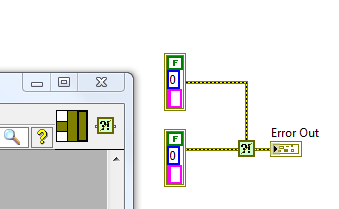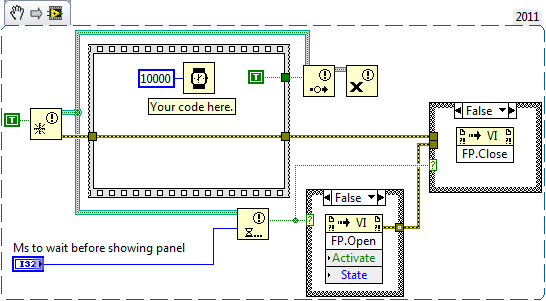Leaderboard
Popular Content
Showing content with the highest reputation on 10/14/2011 in all areas
-
2 points
-
If you are not using POOP (Predominantly Object Oriented Programming) then a lot of the POOP design patterns are no longer relevant since the problem that they solve becomes trivial and most of the mechanics gets handled by the language (yes I'm looking at you "singleton"). With POOP, the problem is usually "State", transitions of state and how to manage it. That's not to say that there aren't any in non-OOP languages, They are just usually called "frameworks" and tend to be more generic. The thing to bear in mind is that design patterns solve a well known problem. But that problem is usually a restriction in the language or paradigm you are using (sometimes called "Idioms" by the Architecture Astronauts). Therefore design patterns tend to be paradigm/language specific (not all...but most). But you have probably been using non-OOP design patterns for quite some time (State Machines, Producer/consumer, Publisher/Subscriber) Take Monads for example (a functional programming design pattern) Sound like VI's and terminals? We (as Labview programmers) have no need for this "pattern" because it is an in-built feature of the language (we chain VIs [monads] together using wires [pipelines] via their terminals [bind/return operators]). A good example of a design "Pattern" that IS useful in Labview is the Producer/Consumer (we all know that one - it's a template in Labview). Why? Because it addresses a restriction of the language (it breaks Dataflow). Most of the time dataflow is our friend (it automagically handles state and imposes strict sequencing in a parallel manner) but when we need asynchronous operations this is a simple generic pattern in our arsenal. So what POOP patterns are useful to us in "classic" labview? As a general rule -.those that break dataflow! So we have a use for things like the "Observer Pattern" or, as we muggles call it, "Publisher/Subscriber". But we also have uses for the more structural patterns such as Strategy (think plugins), State (think state machine) and Facade (think API). although these could arguably be called "idioms" for classical Labview usage. And those that aren't very useful? Well. Most of them Labview itself makes most of the issues associated with POOP patterns fairly trivial. Many are variations on a theme (Mediator and Facade for example). Many revolve around instantiating objects - Creational patterns (we generally define all objects at design time). And many are based around managing communications between objects - Behavioral patterns, (we have wires for that). Why aren't there many references to design patterns outside of POOP? Because they generally solve problems caused by POOP. Now where's my hard-hat.2 points
-
Getting back to the topic at hand, upon closer examination I noticed problems with the original code relating to error propagation. If whatever code you replace the placeholder with returns an error, the notifier will not signal, meaning when an error occurs the VI will always wait the delay before returning even if the error occurs immediately. Consider wiring either the notifier refnum or the boolean from the sequence frame to force execution order instead of the error cluster. Similarly you probably always want the FP to be closed, so the error should not propagate to the invoke node:1 point
-
From the LabVIEW Help: For numeric ranges, specify a range as 10..20, meaning all numbers from 10 to 20 inclusively. You also can use open-ended ranges. For example, ..100 represents all numbers less than or equal to 100, and 100.. represents all numbers greater than or equal to 100. For string ranges, a range of a..c includes all strings beginning with a or b, but not c. A range of a..c,c includes the ending value of c. Not a bug.1 point
-
1 point
-
I am pretty sure you can't - as this is where the dreaded race conditions come into play. I have seen this a bit from older code, that programmed with this not in mind (e.g. lots of globals)... It worked fine on their PC at the time. Move on to different PCs - multi threading, hyper threading, Core 2 Duo - where the timing characteristics of the code are now different and whammo - race conditions start popping up. Same code, different PC.1 point
-
In my experience the terms "reference" and "pointer" are often used interchangably. How are you differentiating the terms? They both essentially do the same thing--they refer to a location in memory that contains either the data of interest or the next memory location in the chain. Having parallel wires refer to the same piece of memory is done all the time with refnums, be it named queues, events, fp controls, etc, so it's obviously possible. Branching a DVR results in two parallel wires referring to the same piece of memory. Is this a limitation of dataflow languages in general or specific to Labview's implementation. Obviously there are still aspects of dataflow I don't fully understand. Data on the parallel by-value wire has to exist somewhere in memory. It don't get why a pointer to that memory location would not be meaningful. It would violate the principle of data flow, but there are lots of things within Labview that do that already. --------- Many Hours Later ----------- I had to look at this for a long time. When I first read it I envisioned all sorts of weird schemes under the hood that used the upstream prim to modify a value after it has been sent downstream. Here's a summary of the conversation I had with your alter-ego, Evil AQ (pronounced "evil-ack"), in my head. Evil AQ explained a lot of things to me, but I question his accuracy... you know, what with him being a figment of my imagination and all. (Note: My conversations with Evil AQ tend to be rather caustic.) Me: "Huh? The prim that created the value is what actually performs operations on the value downstream? That implies that rather than the data being passed around between prims, the data remains with the orignating prim and downstream prims are passed to it. How... odd. That seems kind of like functional programming. I thought you used C++ under the hood." Evil AQ: "No you dolt. That wasn't a comment about perpetually persistent primitives. Look, when have you ever seen a value on a wire change? Me: "I see it all the time. Wire an integer through an increment function inside a while loop. The value on the wire changes with each iteration." EAQ: "Let me rephrase... when have you ever seen a value on a wire change without that section of code executing again? Me: "Well, the value on the wire has changed after going through the increment node." EAQ: "Uh uh. That's a different wire. Another rephrase... when have you ever seen a value on any single wire, defined as all branches starting at the source terminal and ending at each destination terminal, change without that section of code executing again? Me: "Never. Duh." EAQ: "It's good to know you're not a complete maroon. This would be tougher to explain if I were restricted to finger paints and monosyllabic words." Me: "Monobillasic... monosymbolic... monosy... what?" EAQ: "Never mind. What would happen if you had a raw pointer to a value on a wire?" Me: "I could have Interfaces!" EAQ: "Slow down there Flash. Think about this for a minute. What would happen to the value on the wire?" Me: "Ohhhh... it would change." EAQ: "Very good. You pumping a full 100 Watts through that brain or is your dimmer switch turned up a little too high?" Me: "What about control refnums? They change values." EAQ: "There's a reason they're called 'control' refnums. They refer to controls, not wires. Control values can change. Wire values cannot." Me: "Oh. Right. Well queues can change the values of items that exist somewhere in memory. What about them?" EAQ: "Yes, but they are changing the value of an item the queue refnum refers to. They are not changing the value of the queue refnum itself, which is what actually exists on the wire." Me: "I see. But in reality by-val wires don't contain the data itself, do they? If they did memory allocations would take place at the moment the wire branches and I've know that's not right." EAQ: "Correct, wires do not contain the actual data." Me: "It actually refers to data that resides elsewhere in memory, right?" EAQ: "Sort of correct. Wires don't refer to a piece of data so much as they refer to a specific terminal on VIs and primitives. A terminal** is essentially something that can define the values of a piece of data, such as a control, indicator, constant, etc. and includes input and output terminals to prims." (**Evil AQ didn't know the correct terminology for this so he used the word 'terminal.' Luckily I knew what he meant.) Me: "So shouldn't it be possible to create a refnum that simply refers to the same memory location that a wire does? Ha!" EAQ: "Well yes, but it won't work in the way you're thinking. Try looking at it this way... by val data exists only in terminals. Wires are simply a graphical representation of how the terminals are mapped to each other. Ostensibly every time data "flows" across a wire a data copy is made and placed in the memory location that represents the destination terminal. While in principle you could have a refnum that refers to the same data the wire 'refers' to, effectively it would be just like a value property node for one of the terminals. (It doesn't matter which one, since they all contain the same data values.) That scheme would consume LOTS of memory, so the Labview compiler is smart enough reuse memory when it can. For example, since all the terminals a wire connects to must contain the same data values after executing, the memory locations that are represented by the terminals are actually pointers that refer to a single piece of data. Sometimes the memory location of that data can be reused by other terminals further downstream. Sometimes it can't. Ironically, obtaining a reference to that memory location is one way to guarantee it can not be reused." Me: "Really?" EAQ: "Well yeah. You're referencing the value in the terminal, which doesn't change until that section of code executes again. If downstream operations change the value a new copy must be made to avoid corrupting the old copy, which you have a reference to." Me: "I get it now. Thanks Evil AQ. You're the greatest." EAQ: "You sound like my mother. Now beat it punk, I'm trying to sleep." So did Evil AQ do a decent job of explaining things to me?1 point








